Healthiest Seafood Options, Ranked
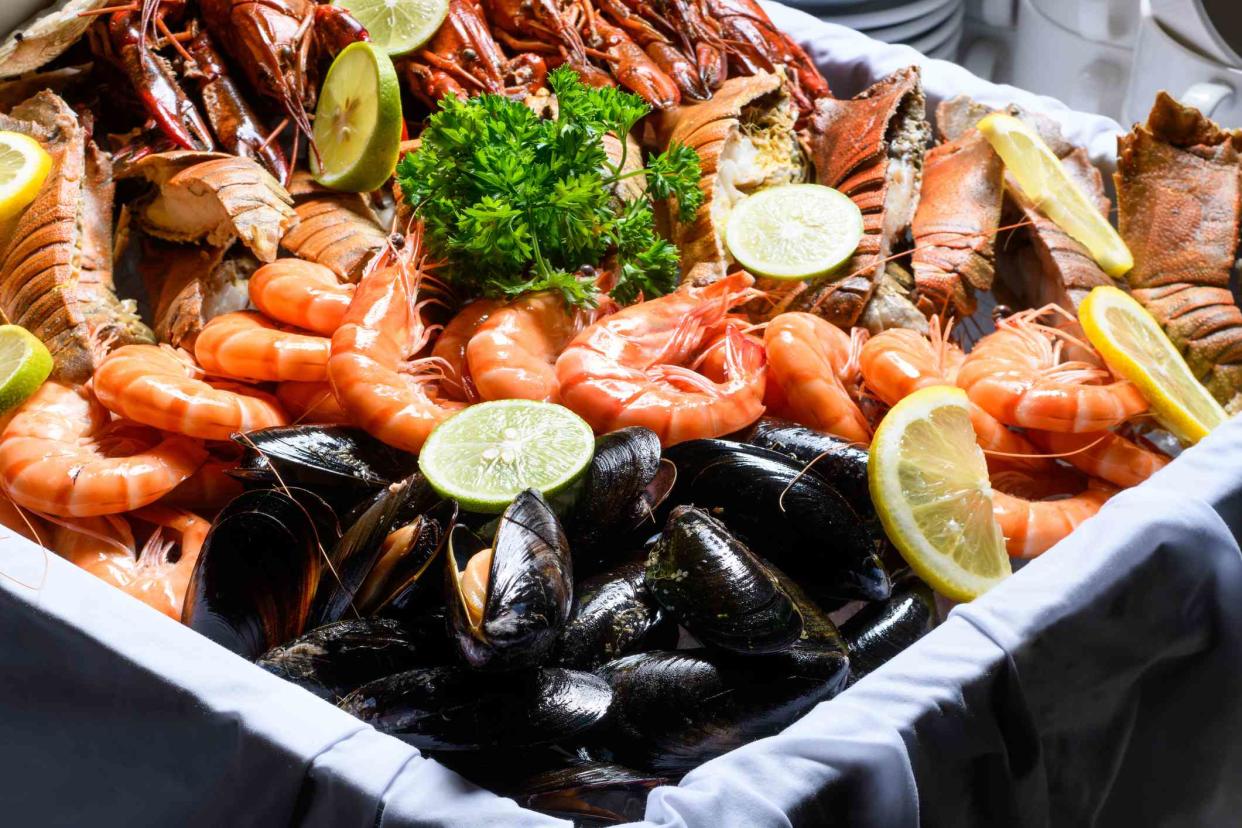
Jordan Lye / Getty Images
Medically reviewed by Kayla Girgen, RD
Seafood is a collective term that refers to fish, mollusks, crustaceans, and echinoderms. Seafood, like salmon, clams, and oysters, is rich in nutrients like protein, B12, iron, selenium, zinc, and vitamin D, many of which tend to be low in modern-day diets.
Seafood is also the primary dietary source of the omega-3 fats eicosapentaenoic acid (EPA) and docosahexaenoic acid (DHA). EPA and DHA have powerful anti-inflammatory effects on the body and help prevent cellular damage that may otherwise lead to disease.
Studies also show that regularly eating seafood could reduce the risk of several common health conditions, such as colorectal cancer and heart disease.
While seafood can be a healthy choice, some types of seafood are recommended over others due to their nutritional content, sustainability, and low levels of contaminants, like mercury.
1. Sardines
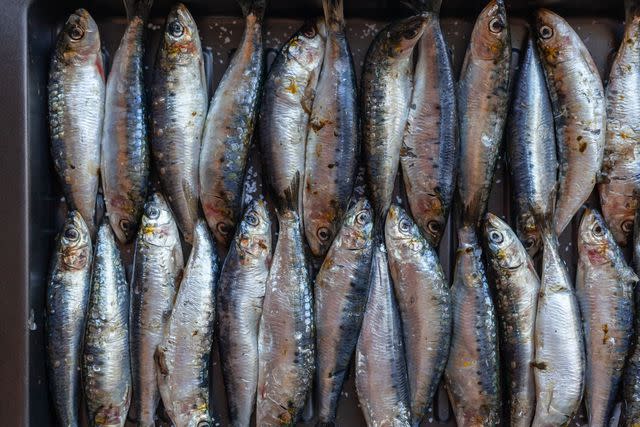
mjrodafotografia / Getty Images
Though sardines are often overlooked in favor of more popular fish like salmon and trout, they’re one of the most nutritious seafood types. These tiny fish are packed with nutrients your body requires for optimal health, such as protein, iron, vitamin E, selenium, B12, and calcium.
Just one 3.75-ounce can of sardines provides 343%, 88%, 27%, 15%, and 13%, of your daily needs for B12, selenium, calcium, iron, and vitamin E, respectively. They’re also an excellent source of the anti-inflammatory omega-3 fats EPA and DHA. Sardines are so high in omega-3s that researchers suggest that eating more sardines could reduce the need for omega-3 supplements.
In addition to omega-3s, which are important for heart health, sardines contain other cardioprotective nutrients, such as calcium, magnesium, potassium, and amino acids like taurine and arginine, making them a smart choice for your heart.
Sardines are much more affordable than other types of seafood. Try adding sardines to dishes like salads and pasta for a boost of nutrition.
2. Mackerel
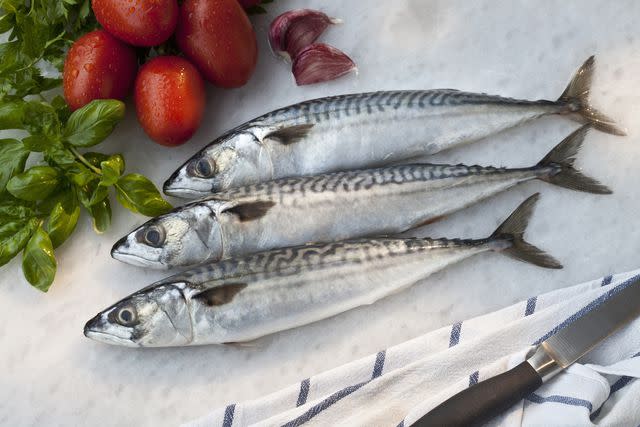
Buena Vista Images / Getty Images
Like sardines, mackerel provides nutrients like B12 and selenium, with a 3-ounce serving covering 675% and 78% of these nutrients, respectively. B12 is required for red blood cell production, neurological function, metabolism, and DNA synthesis, while selenium plays critical roles in immune and thyroid function and acts as a powerful antioxidant in the body.
Mackerel is also a good source of the mineral magnesium, which is necessary for critical processes such as nerve function, DNA synthesis, blood sugar and blood pressure regulation, stress response, and bone health. The same serving listed above provides 20% of your daily magnesium needs.
In addition to being highly nutritious, mackerel are less likely to accumulate high levels of the toxic heavy metal mercury than larger fish, making them a safe choice for health.
3. Herring
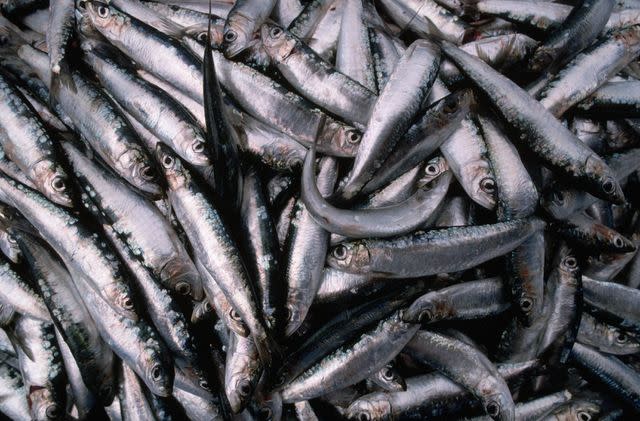
Jim Sugar / Getty Images
Like sardines and mackerel, herring are rich in omega-3s. In addition to omega-3s, research shows that herring are packed with vitamin E, vitamin D, and B12, as well as minerals like selenium, iodine, calcium, and iron.
Herring is low in toxins like lead, cadmium, and mercury, making herring a nutritious and safe seafood option to add to your diet.
4. Clams
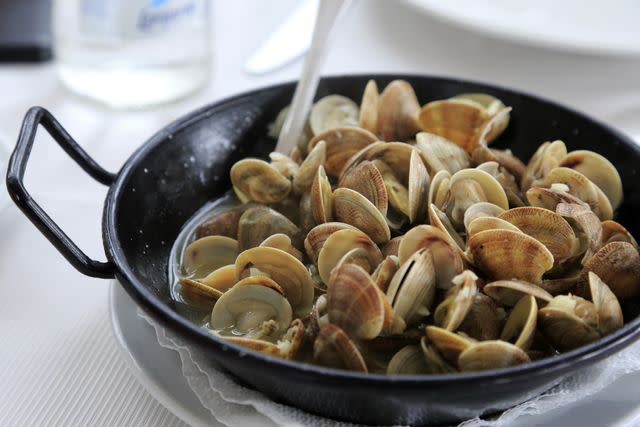
Bruce Yuanyue Bi / Getty Images
Clams are low in mercury yet high in several essential vitamins and minerals, such as B12. A 3-ounce serving of cooked clams covers over 3,000% of your daily needs for vitamin B12, making it an excellent source of this critical vitamin. Clams are also rich in minerals like zinc and selenium, both essential for immune function.
Clams, especially farmed clams, are among the most sustainable seafood types you can eat. They are also affordable and versatile and can be purchased fresh, frozen, or canned, making them a smart seafood option for those on a budget.
5. Trout
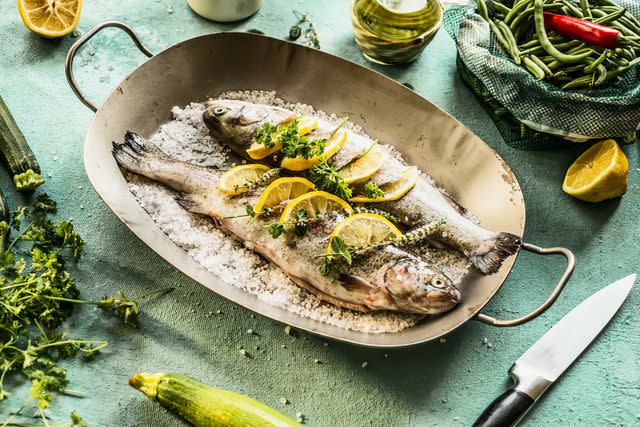
VICUSCHKA / Getty Images
Trout is a fatty fish that’s concentrated in omega-3 fatty acids and fat-soluble vitamins such as vitamin D. Vitamin D promotes the absorption of calcium, which is essential for skeletal health maintenance. It also regulates inflammation in the body, supports immune health, and plays many other crucial roles in the body.
Trout is one of the few foods that provide high amounts of vitamin D. A 3-ounce serving of cooked trout provides 645 International Units (IU) of vitamin D, or 81% of your daily needs, making it an excellent choice for people looking for natural ways to boost their vitamin D levels. In addition to vitamin D, trout is high in protein, zinc, selenium, and B12, making it an all-around healthy choice.
Try baking or sautéing trout with olive oil and fresh herbs and serve it with roasted vegetables for a satisfying and nutritious meal.
6. Oysters
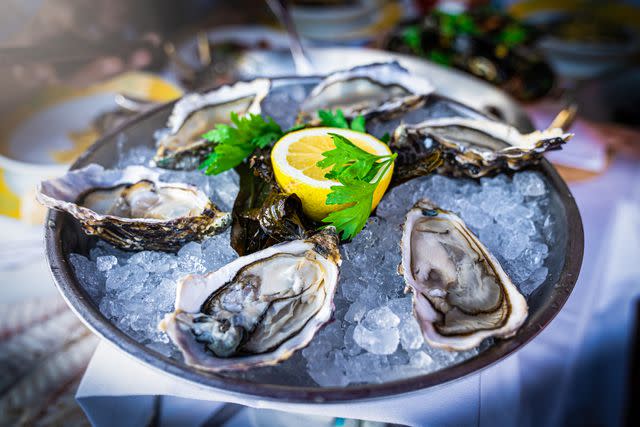
wilatlak villette / Getty Images
In addition to being delicious, oysters provide a number of nutrients, including protein, omega-3 fats, B12, selenium, zinc, and copper. A 100-gram serving of oysters covers more than 100% of your daily needs for B12, zinc, and copper, and over 50% of your needs for selenium. They’re also rich in iron, making them a good choice for people with increased iron needs, like people with iron deficiency anemia.
Oysters are low in calories, yet high in protein, which is the most satiating macronutrient. A 3-ounce serving of oysters contains just 126 calories, yet is packed with nearly 22 grams of protein. Adding protein-rich oysters to meals and snacks can help you feel full after eating, which can help support healthy body weight maintenance.
7. Salmon
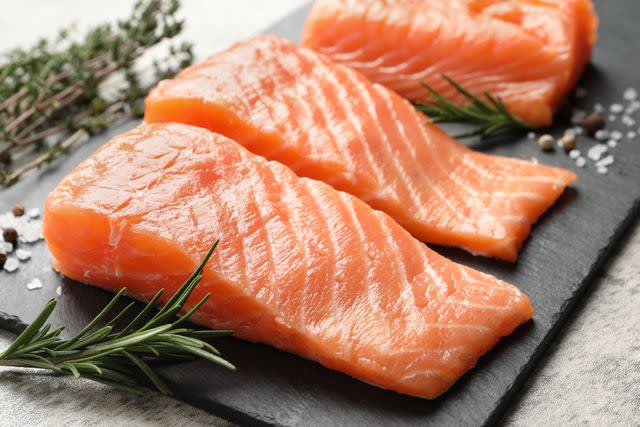
Liudmila Chernetska / Getty Images
Rich in nutrients and packed with flavor, salmon is one of the most popular types of seafood in the U.S. Salmon is an excellent source of nutrients, with a 154-gram serving of wild-caught salmon covering 21%, 85%, 131%, and 196%, and of the DV for potassium, B6, selenium, and B12, respectively. The same serving provides an impressive 39 grams of protein, making it a particularly filling seafood option.
In addition to vitamins, minerals, and protein, salmon is high in the omega-3 fats DHA and EPA, as well as the powerful antioxidant astaxanthin. Astaxanthin is a carotenoid pigment that gives salmon its reddish color. Astaxanthin has cellular-protective properties and consuming astaxanthin-rich foods, like salmon, may help protect against conditions such as cognitive decline and help support overall health.
8. Shrimp
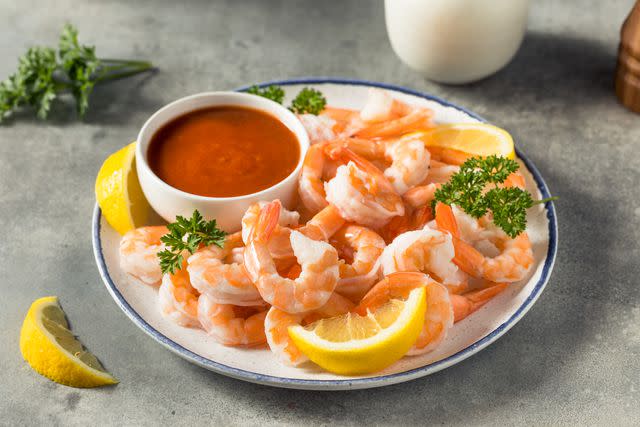
bhofack2 / Getty Images
Like salmon, the pink color of shrimp comes from its high levels of astaxanthin. Astaxanthin is a potent antioxidant, which can help protect against oxidative stress. In fact, studies show that astaxanthin's antioxidant activity is up to 500 times higher than that of vitamin E and β‐carotene.
Shrimp also provides essential nutrients like B12, selenium, zinc, and protein, and is delicious in dishes like pastas, salads, and grain bowls.
9. Crab
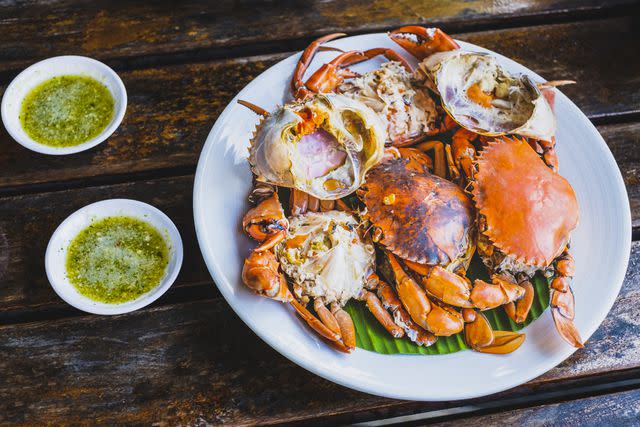
Sutthiwat Srikhrueadam / Getty Images
Crab meat is rich in nutrients like B vitamins, selenium, and zinc. A 3-ounce serving of cooked blue crab covers 29% of your daily needs for zinc, a mineral needed for many critical processes in your body, such as immune function, protein and DNA synthesis, and cell division.
Crab is also a good source of heart-protective omega-3 fats, providing between 200 milligrams to 550 milligrams of EPA and DHA per 4-ounce serving.
10. Lobster
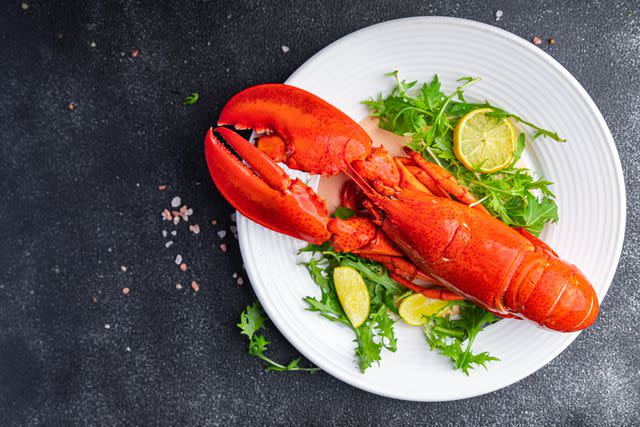
a-lesa / Getty Images
With its buttery flavor and tender texture, lobster is one of the most popular types of shellfish. In addition to being delicious, lobster is incredibly nutritious, providing protein, vitamins, minerals, and healthy fats.
A 3-ounce serving of cooked lobster contains over 16 grams of protein and covers 31% and 113% of your needs for zinc and selenium, respectively. It's also high in B12 and copper, a mineral required for red blood cell production.
11. Cod
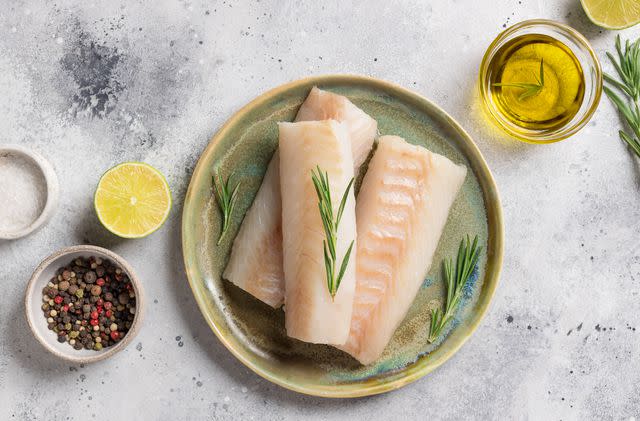
Mila Naumova / Getty Images
If you're looking for a mild-tasting fish that's packed with protein, consider adding cod to your diet. A 180-gram cod fillet provides an impressive 41 grams of protein, which can help support satiety, blood sugar regulation, and muscle mass maintenance.
Choosing lower-calorie, higher-protein foods, like cod, can promote a healthy body weight by increasing feelings of fullness, which may curb your appetite, reduce snacking, and help you cut back on your calorie intake.
The mild flavor of cod makes it a good choice for people who want to add more seafood into their diet, but don't like strong-tasting fish.
12. Tuna
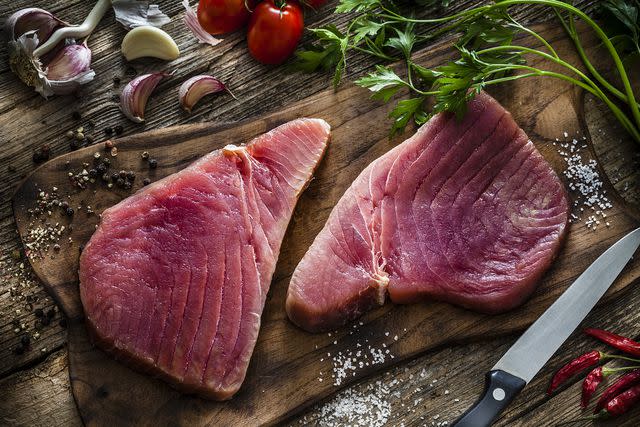
fcafotodigital / Getty Images
Tuna is one of the most affordable and accessible types of seafood. Canned tuna is inexpensive and shelf-stable, meaning it doesn't require refrigeration.
Tuna is also nutritious, providing a number of essential vitamins, minerals, and omega-3 fats. In addition to omega-3 fats, tuna provides nutrients like B12, vitamin D, iron, and selenium, which are lacking in many people’s diets.
However, raw and canned tuna contains the heavy metal mercury. Some tuna species, such as bigeye tuna, are especially high in mercury and should be avoided. Canned light tuna, the lowest in mercury, can be enjoyed up to three times per week.
13. Mussels
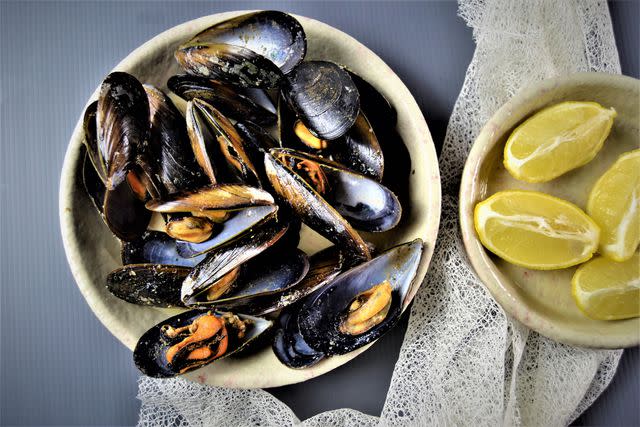
Blanchi Costela / Getty Images
Mussels, especially farmed mussels, are more environmentally-friendly compared to other animal proteins, such as beef, which is associated with high greenhouse gas emissions. Swapping beef with farmed mussels can reduce your carbon footprint, which lowers your environmental impact.
A 100-gram serving of mussels contains 23.8 grams of protein, which is just 1 gram less than what's found in the same serving of ground beef. Mussels are also a good source of vitamins and minerals, like B12 and iron.
14. Scallops

Thomas Barwick / Getty Images
Scallops are a source of lean protein that's high in the amino acids taurine and glycine. These amino acids may protect against the development of atherosclerosis, or the thickening or hardening of the arteries caused by a buildup of plaque. Atherosclerosis is the main cause of heart disease.
These amino acids may help reduce blood lipid levels and decrease oxidative stress, which may help protect against atherosclerosis development. Scallops are also low in mercury and high in nutrients like B12, zinc, and selenium.
15. Halibut
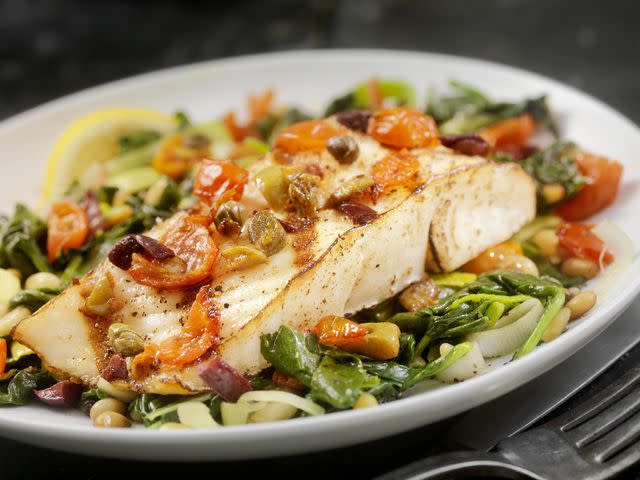
LauriPatterson / Getty Images
Halibut is a mild-tasting white fish that's high in several important nutrients, such as protein, selenium, B12, and B6.
While halibut is nutritious and tasty, it is higher in mercury than other fish. For this reason, the FDA recommends limiting your halibut intake to one serving per week.
Risks of Eating Seafood
While seafood can be a nutritious choice and help fill dietary nutrient gaps, there are some environmental- and health-related concerns related to seafood consumption.
For example, seafood can contain toxins and other compounds like viruses, parasites, and bacteria that can make you sick. Therefore, you want to cook fish and shellfish thoroughly. According to the USDA, most seafood should be cooked to an internal temperature of 145 degrees.
Mercury and Other Contaminants
Certain types of seafood are high in contaminants that can harm health if over-consumed. For example, certain fish are high in mercury, a heavy metal readily absorbed by the body. Larger fish tend to be higher in mercury than smaller fish because their diet consists of smaller fish that consume mercury-rich plankton. This is why larger and older fish tend to be the highest in mercury.
Mercury is toxic to the body, and regularly consuming foods high in mercury can lead to mercury accumulation, which can cause health issues such as high blood pressure, heart attack, and developmental delay in offspring.
Certain populations, including pregnant and breastfeeding women and children, are more vulnerable to the effects of mercury.
Though mercury accumulation in seafood is a concern, avoiding mercury-rich seafood, such as shark, certain types of tuna, swordfish, tilefish, and king mackerel, and opting for low-mercury options, like trout, cod, oysters, clams, herring, salmon, and sardines, can help prevent dietary mercury exposure.
Microplastics
Another concern related to eating seafood is that seafood is contaminated with microplastics, or tiny pieces of plastic measuring less than 5 millimeters in length. Due to human-generated pollution, microplastics accumulate in marine habitats like bays and oceans.
Not only do microplastics harm the environment, but experts warn that consuming seafood high in microplastics can harm human health. Microplastics are absorbed through the gastrointestinal tract and may trigger inflammation and damage cells. Although it’s clear that microplastics are harmful to health, more research is needed to understand how consuming seafood containing microplastics impacts disease risk.
Environmental and Ethical Concerns
In addition to human health concerns, there are environmental and ethical issues related to consuming seafood. The growing population has put immense pressure on marine environments, and the high demand for seafood has led to overfishing, destruction of fragile marine environments, and dwindling populations of vulnerable marine species like turtles, sharks, and dolphins.
This is why it’s critical to choose seafood caught or produced using sustainable practices. The Monterey Bay Aquarium Seafood Watch offers an online database that can help you narrow down the most sustainable types of seafood. Also, though seafood can be a part of a healthy diet, you can further reduce your environmental impact by cutting back on your animal protein intake and replacing animal proteins with plant-based proteins, like beans and lentils.
Tips for Adding Seafood to Your Diet
Eating seafood can boost the quality of your diet and support and protect your health. However, it’s important to consider the nutrition and environmental impact of seafood when narrowing down options to add to your diet.
Here are a few tips that can help you add seafood to your diet in a healthy and environmentally friendly way:
Choose sustainable seafood: Some types of seafood are more sustainable than others. According to the Monterey Bay Aquarium Seafood Watch, U.S. and Canadian wild-caught salmon, U.S.-farmed rainbow trout, Atka mackerel caught in Alaska, and clams are among the best choices.
Limit fried seafood: Frying seafood leads to the formation of harmful compounds, such as heterocyclic amines (HCAs), acrolein, and aldehydes, which may increase the risk of certain health conditions, like cancer. This is why it’s best to limit fried food intake and choose healthier cooking methods like baking or sautéing whenever possible.
Avoid seafood high in mercury: Because mercury can harm health, it’s best to choose low-mercury seafood like trout, herring, clams, and oysters and avoid high-mercury fish like tilefish, marlin, swordfish, and shark.
Include seafood as part of a well-rounded diet: Though seafood is highly nutritious, including seafood in your diet is just one way to improve your health and the quality of your eating pattern. In addition to seafood, it’s important to consume other healthful foods, such as fruits and vegetables, beans, nuts, and seeds.
Following these tips can help you include more nutritious and sustainable seafood options.
A Quick Review
Eating more seafood, like fish and shellfish, can increase your intake of essential nutrients, like protein, vitamins, minerals, and healthy fats, and may reduce your risk of several common health conditions.
While there are a number of healthy seafood options available, sardines, salmon, oysters, mackerel, trout, and clams are among the most nutritious and sustainable choices.
Try preparing these seafood options using cooking methods like baking and sautéing for an easy and delicious way to support your health.
For more Health.com news, make sure to sign up for our newsletter!
Read the original article on Health.com.
